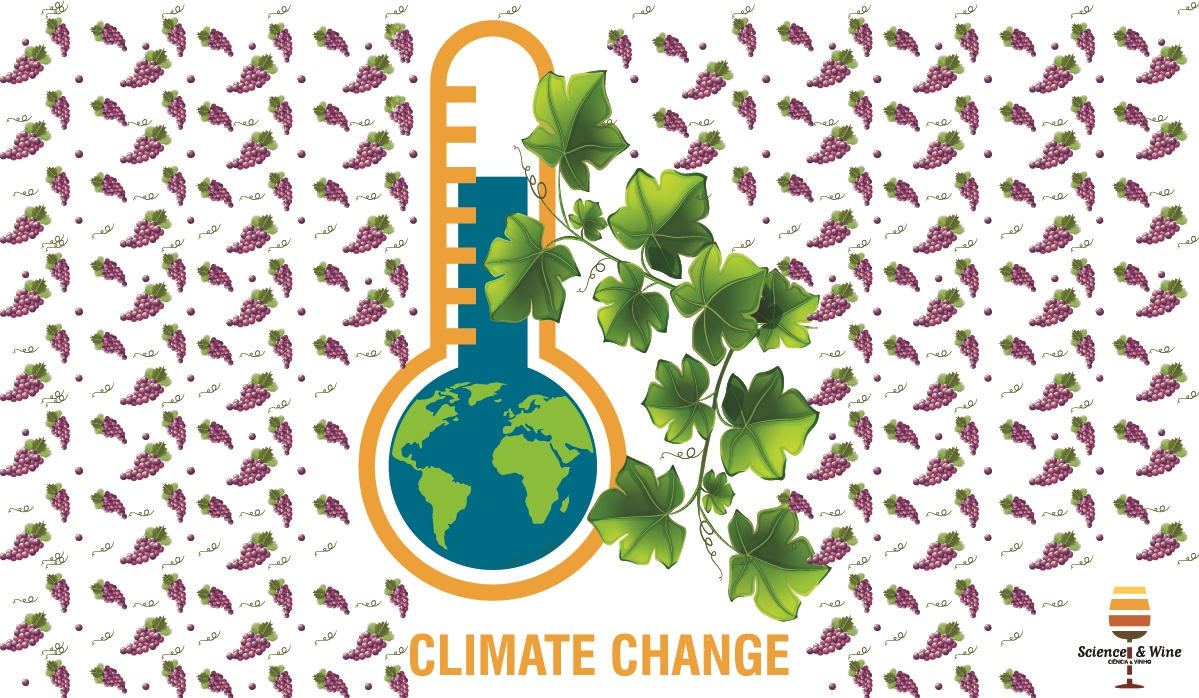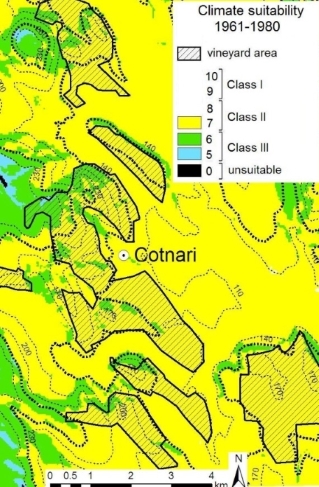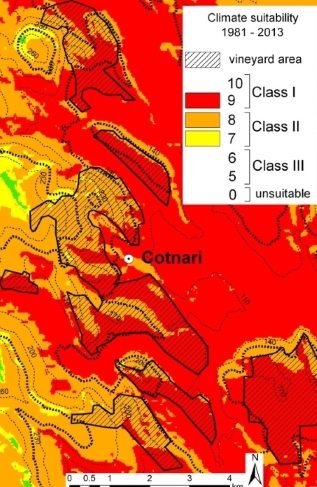By CLiviu Mihai Irimia, Hervé Quénol and Cristian Valeriu Patriche
One of the broadly debated topics during the last three decades has been the climate change, a phenomenon with global manifestation and whose evolution and finality are far from being known. Perhaps that is the uncertainty that makes concerns even bigger. All the more so, we all notice, that human society is affected in its entirety, seeking solutions to adapt. About 0.89 °C increase in the average of global temperature during the XX century has brought an increase in the frequency of extreme phenomena, while for the end of the XXI century an increase of 1,4…5,8 °C in the average of the the global temperature is predicted (IPCC, 2013). Human society is entirely affected, from basic aspects like water and food resources, health and education to the various sectors of the economy: agriculture, tourism, transport, etc.
Viticulture, a multi-billion-dollars industry (Anderson and Nelgen, 2011), including 7.5 mln ha of plantations, thousands of wine producing companies and an important contribution to tourism industry is equally affected (Lallanilla, 2013). According to research in the last two decades, climate change modify the potential of wine regions on globe and affects the well-known sensory profile of wines, determining difficulties in grape growing, producing wine and wine capitalization. For this reasons, the influence of climate change on viticulture is of major interest and is studied in all its details, while the consequences are assessed in relation to their impact.
The impact relates mainly to temperature influence on the growth, fruiting and chemical composition of grapes in grapevine (Vitis vinifera L.). This species is more sensitive to temperature than many other crops, which is why, globally, its area of culture is restricted to 30-50 ° lat. N and 30-40 °lat. S, in zones with an average temperature of the growing season (AvGST, April-October/October-April) of 12…22 °C (Jones 2006). In areas with AvGST of less than 12 °C, grapes do not ripe and the vine is destroyed by the winter frosts; while in areas with an AvGST above 22 °C, the chemical composition of grapes is affected by the increase of sugar content, acidity diminution and degradation of flavors and anthocyanins. The same thermal sensitivity of the grapevine makes it possible to obtain sparkling wines and white table wines in the areas with average temperatures of July from 18.1 to 19.7 °C; quality white wines in areas with a July average temperature higher than 19.8 °C; and quality red wines in areas with an average temperature of July higher than 21 °C (Irimia, 2012). Therefore, a strict dependence of grapevine and of wine quality on climate and in particular on temperature.
In fact, vineyards have been established over the centuries according to the climate, the relief and the soils of the area, maintaining in culture the best adapted grapevine varieties and selecting the training systems that capitalize best their quality potential under those conditions. For this reason, the increase of temperatures on the background of climate change is seen as a factor that can alter the climatic profile of the vineyards and, together with it, the well-known wine sensory profile. Moreover, according to important research of the last decade (Hannah et al., 2013, Moriondo et al., 2013), with the rise of temperatures, there is a danger that in the Mediterranean climate, where the thermal regime is already at the upper limit of suitability for quality wine production, viticulture will become economically unviable. Reference is made to world’s famous wine regions such as Vallée du Rhône – France, Barolo-Italy, where the average temperature of the growing season increased between 1950 and 1999 by 1.26 to 4,07 °C (Jones et al., 2005). By contrast, the wine regions located close to the northern limits of the grapevine growing area (Rhine Valley, Moselle Valley, Champagne, Alsace) benefit by a climate improvement that becomes more and more suitable to quality wine production (Jones et al., 2005). Moreover, climate warming leads to the expansion of viticulture in areas previously considered too cold for Vitis vinifera L., such as Quebec, Canada; Kamloops, Canada; Zilona Góra, Poland; Aalborg, Denmark; or even Gothenburg, Sweden, located at 57.70 ° N (Jones and Schultz, 2016) where the growing of cold-resistant hybrids Rondo, Vidal, Regent and early varieties such as Madeleine Angevine and Siegerrebe mark the beginning of viticulture as a local occupation. In the future, if climatic warming is to continue, more valuable varieties such as Müller-Thurgau, Chardonnay, Pinot Noir, Riesling, Pinot Gris and Sauvignon Blanc will be introduced into these regions and will produce better wines. This context also explains the efforts that scientists are making to understand the impact of climate change on grapevine and wine production, to anticipate future developments and to find ways to adapt viticulture to climate change. The aim is to preserve the vineyards’ specificity and, in particular, to preserve the well-known, specific wine sensory profile unaltered.
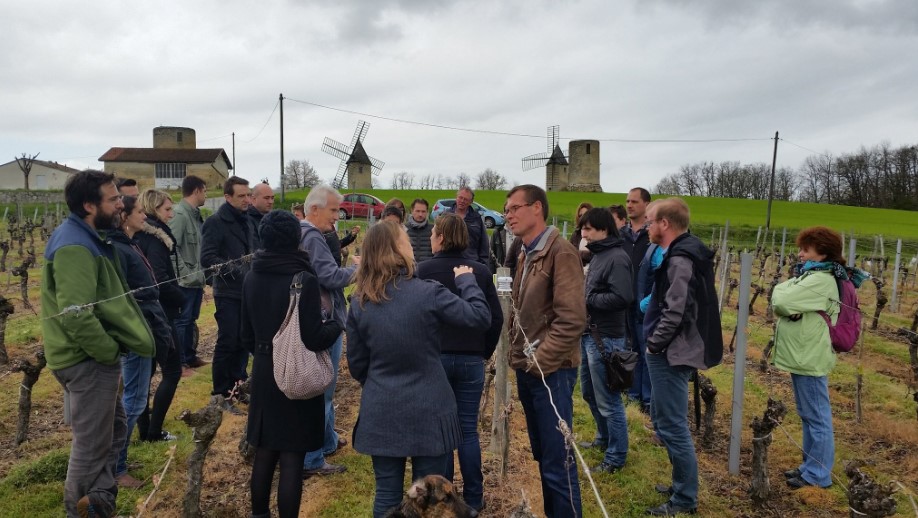
Since Europe is the main wine producer and the owner of the world’s most famous wine regions, the efforts that are being made here to understand, forecast and control the influence of climate change on viticulture are by far the most significant. In this sphere of study is included the research carried out since 2014 in the framework of the European project LIFE ADVICLIM, coordinated by CNRS/University Rennes 2 (France) and having PhD Hervé Quénol of UMR6554LETG Centre as a Director. This project brings together viticulture and climatology specialists from France, Germany, United Kingdom, Romania and Spain aiming to find solutions to adapt viticulture to climate change. The pilot sites of the project are located in Saint Emillion – Bordeaux; Saumur Champigny and Coteaux du Layon – Val de Loire, France; Plumpton – South Sussex, United Kingdom; Rüdesheim – Rheingau, Germany; Cotnari – Romania; and Ausejo and Carbonera – La Rioja, Spain, vineyards and wine regions representing the climatic diversity of European viticulture. The specialists of the ADVICLIM project come from Bordeaux Sciences Agro, INRA Angers-Nantes, CNRS, University of Rennes 2, French Institute for Vine and Wine, ECOCLIMASOL (France); Hochschule Geisenheim University (Germany); University of Agricultural Sciences Iaşi (Romania); Plumpton College (United Kingdom); Public University of Navarra (Spain).
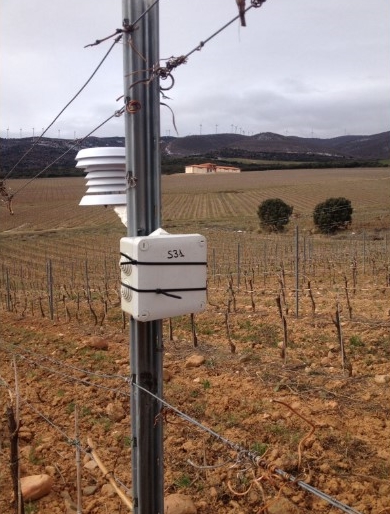
Using networks of temperature sensors that record temperature variation in each pilot site, the project aims to identify the changes occurring in the climate of vineyards on a fine scale, to determine the impact of these changes on grapevine phenology and on grapes chemical composition and, depending on it, also to offer solutions for adapting vineyards management to the new climatic context (Quénol et al., 2014).
The results achieved so far in the ADVICLIM project have revealed, indeed, major changes in the climate suitability for the wine growing in all studied wine regions, regardless of the climate type: changes in the multiannual average of bioclimatic indices (Huglin index, Oenoclimate Aptitude Index, Average Growing Season Temperature etc.), indicating, in some cases, that the vineyards climate passed to another class of suitability for the wine production. Such an example is the Cotnari wine region in Romania, a traditional white wine producer that, due to temperature increasing, has switched to the production of red wines too (Irimia et al., 2016). These changes are very obvious on the maps of viticulture potential developed within the ADVICLIM project and which local viticulturists use to develop their strategy of adapting their vineland holdings to climate change.
Figure 3: Maps of climate suitability for the wine production, for the Cotnari wine region (Romania) https://link.springer.com/article/10.1007/s00704-017-2033-9
Similar changes have taken place in the other pilot sites of the project: an increase in heliothermal resources that still favor the autochthonous Tempranillo variety in Ausejo – La Rioja, Spain; the occurrence of climate suitability for the wine production in Carbonera – La Rioja, at higher altitude of about 850 m asl, unsuitable for viticulture in the past; an increase in the heliothermal resources of the local climate in Saint-Émilion – Bordeaux, which makes the wines of last decades amid climate warming to be comparable to the best millésimes of 50-60 years ago; an increase in the heliothermal resources that adds a plus of quality to white wines produced in Rüdesheim, on the spectacular slopes of the Rhine Valley, a Nordic, cool area, where the research made within the ADVICLIM project have indicated that even the production of red wines of varieties such as Pinot noir, Merlot and Cabernet Franc will soon be possible; also increases in climate suitability for wine production in Plumpton, South Sussex – UK, where the climate, still remaining at the lower limit of suitability for viticulture, indicates that besides the excellent sparkling wines of the area, excellent quality white wines in the near future it will be possible to produce.
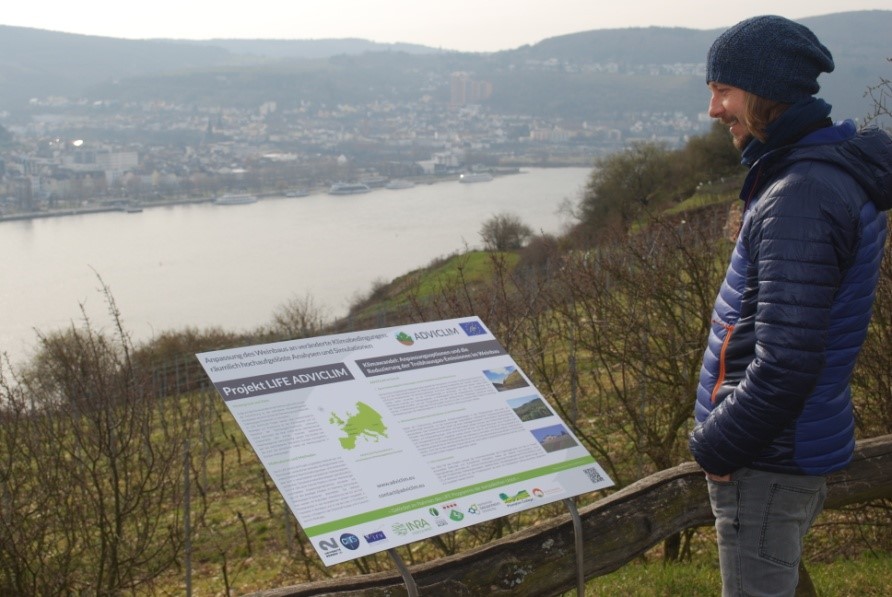
Beyond these developments, the results of the ADVICLIM project confirm the changes of climatic suitability for the wine production predicted in last decade in reference studies (Jones et al., 2005; Hannah et al., 2013; Moriondo et al., 2013). These shifts do not mean just changes in local climate, switches from suitability for white wines to suitability for red wines too, as in the case of the Cotnari or the Rheingau wine regions. It also means significant spatial shifts, namely shifting the area of climate suitability for the production of a certain wine type to higher altitude, if the relief allows, and to northern, cooler latitudes. These shifts are described in a study on the impact of climate change on Romania’s viticulture (Irimia et al., 2017). It was found that the area suitable for wine production expanded on altitude about 180 m asl, from 650 m asl in the past to about 830 m asl at present. It also expanded to north by 0.036°; what is more, each class of suitability that determines a certain type of wine production shifts to higher altitude. The research carried out in the ADVICLIM project has revealed similar shifts of suitability in all areas with hilly relief: on the Rhein Valley, in Rheingau, the cool climate specific to the area, suitable for wine grape varieties such as Müller-Thurgau and Riesling moves higher on altitude from an average of 110 m asl in the past (1950-1990) to about 210 m asl at present, being replaced in the low area at 60-70 m asl by a new class of suitability, which allows the cultivation of the Cabernet Franc and Merlot varieties. Also, in Spain, in Ausejo, the climate suitable for Tempranillo and Grenache moves above 80 m asl, from an average of about 320 m asl in the past to about 400 m asl today. Regarding the latitude movements, appreciated on the fine scale of the vineyard, they are hard to detect, and yet the research made in the ADVICLIM project has found out such shifts, e.g. in the La Rioja region, where the temperate – warm climate, suitable for Grenache and Tempranillo shifted from an average latitude of 42,327 °N lat. to 42,427 °N lat.; or on the Rhine Valley, where the cool climate specific to the area shifted from an average latitude of 49,960 °N lat. to an average latitude of 49,987 °N lat.
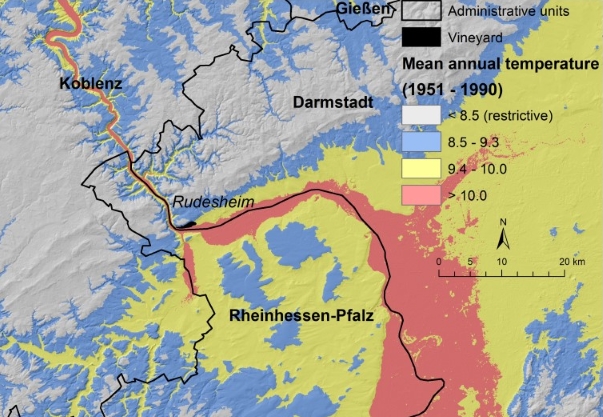
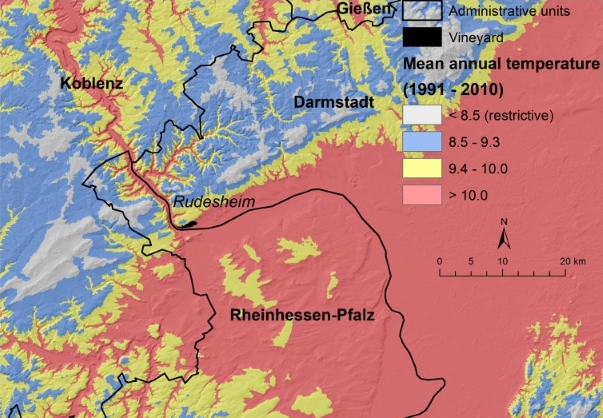
Hence major shifts in climate suitability for the grapevine growing and wine production in all wine regions studied within the ADVICLIM project, regardless of their climate, and which predict shifts in the structure of winetype production in European viticulture. At this moment the impact is absolutely favorable for the studied wine growing regions, the adaptation consisting, in general, in capitalization of the new opportunities brought by the climate change. However, if this phenomenon continues in the direction of increasing temperatures up to the limits of suitability for the wine production there could be serious consequences on the areas of DOC wine production and on the wine’s well-known sensory profile. The potential for adaptation to climate change of some wine regions is larger while others is more limited, but the slow evolution of these shifts in time will enable the wine industry and consumers to become accustomed to a situation arising from a possible new climate context.
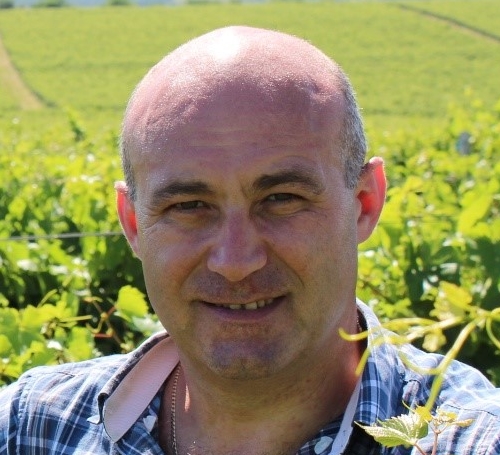
Liviu Mihai Irimia is an Associate Professor at the University of Agricultural Sciences of Iasi (USAMV, Iași, Romania), Department of Horticultural Technologies. His entire professional career is related to Viticulture, starting with the fact that he originate in an important wine-growing region of Romania (Husi wine-growing region) and completes his current activity as a researcher and professor in Viticulture. His expertise in Viticulture is a mix of in-depth knowledge gained through study, practical experience, scientific research and professor over 23 years (1994-2017). Graduate of the Faculty of Horticulture in Iasi USAMV (1994) with a license in the study of new Romanian grapevine varieties; manager of a vine plantation of 100 ha between 1994-2002; student of Bourgogne University (France), Institute Universitaire de Vigne et du Vin Jules Guyot (2005); PhD in Viticulture-Oenology at USAMV Iasi, Romania (2006); assistant professor and later lecturer in Viticulture – Ampelography at the USAMV Iasi, between 2002-2012; researcher in Viticulture with expertise in the study of vine training systems, GIS-based analysis of wine-growing areas and viticultural climatology.
Collaborator of CNRS France (LETG COSTEL) in the research projects JC 07-194103 TERVICLIM (2008-2012) and GICC-TERADCLIM (2011-2013); responsible for the USAMV Iasi (Romania) partner in the European project Life ADVICLIM (2014-2019) coordinated by Rennes 2 University (France); Director of the 7BG / 2016 AVEVINPERFORM (2016-2018) research project of the UEFISCDI Romania. Member of the Chaire UNESCO “Culture et Traditions du Vin” of the University of Bourgogne (France), from 2012 and member of the Romanian Society of Horticulturists from 2006. National prizes for scientific articles 2015 and 2016 and OIV Mention (2015) as co-author of the book Changement climatique et terroirs viticoles, Ed. Lavoisier Tec & Doc (France). Author of about 60 scientific papers in the field of Viticulture and of the book Biology, Ecology and Physiology of the Grapevine (2012). As a researcher, Liviu Mihai Irimia collaborates currently with personalities of world viticulture from France, Germany, England, Spain, New Zealand and USA, mainly in studying the impact of climate change on Viticulture.
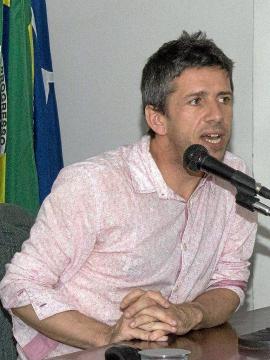
Hervé Quénol is geographer-climatologist working as senior scientist at the National Centre for Scientific Research (CNRS) in the LETG (Littoral Environment Remote-Sensing Geomatics) laboratory (Rennes, France). Visiting researcher at the University of Canterbury (2016-2018). His research group focuses on the interactions between climate and anthropic activities. His research group focuses research on analyses and modelling of climate at fine scales in the climate change context; Climatology and Viticulture; Urban climatology. He the European Environment-LIFE project ADapatation of VIticulture to CLIMate change: High resolution observations of adaptation scenario for viticulture 2014-2019. He is also the contact person for the http://www.adviclim.eu/ web site.

Patriche Cristian Valeriu works within the Romanian Academy, Department of Iasi, Geography Group as a senior research scientist. He has a PhD in geography since 2004 and more than 20 years of research experience. His expertise includes applications of geographical information systems, statistical analysis and remote sensing mainly in geomorphology, climatology and agroclimatology, soil science. The most important such applications refer to ecological suitability evaluation for viticulture, soil erosion modelling, landslide susceptibility assessment, digital mapping of climate and soil parameters.
References
- Anderson K, Nelgen S (2011) Global Wine Markets, 1961 to 2009: A statistical compendium. University of Adelaide Press.
- Hannah L, Roehrdanz PR, Ikegami M, Shepard AV, Shaw MR, Tabor G, Zhi L, Marquet PA, Hijmans RJ (2013) Climate change, wine and conservation. Proc Natl Acad Sci USA, 110(17): 6907–6912. doi: 10.1073/pnas.121012711
- IPCC (2013) Climate Change 2013: The Physical Science Basis. Contribution of Working Group I to the Fifth Assessment Report of the Intergovernmental Panel on Climate Change. In: Stocker TF, Qin D, Plattner G-K, Tignor M, Allen SK, Boschung J, Nauels A, Xia Y, Bex V, Midgley PM (eds). Cambridge University Press: Cambridge, United Kingdom and New York, NY, 1535 pp.
- Irimia L.M., Patriche C.V., Quenol H., Sfîcă L., Foss C. 2016. Shifts in climate suitability for wine production as a result of climate change in a temperate climate wine region of Romania. Theor Appl Climatol https://link.springer.com/article/10.1007/s00704-017-2033-9
- Irimia L.M., 2012. Biologia, ecologia şi fiziologia viţei de vie (Biology, ecology and physiology of the grapevine), Ed. “Ion Ionescu de la Brad” Iasi, 259 pag., ISBN 978-973-147-106-8.
- Jones GV, White MA, Cooper OR, Storchmann K (2005) Climate change and global wine quality. Clim Change 73:319–343. doi: 10.1007/s10584-005-4704-2
- Irimia L.M., Patriche C.V., Roșca B. 2017. Climate change impact on climate suitability for wine production in Romania. Theor Appl Climatol, https://link.springer.com/article/10.1007/s00704-017-2156-z
- Jones GV (2006) Climate and terroir: impacts of climate variability and change on wine. In: Macqueen RW, Meinert LD (eds) Fine wine and terroir-The geoscience perspective. Geoscience Canada Reprint Series No. 9, Geological Association of Canada, St. John’s, Newfoundland, p 247
- Jones GV, Schultz R., (2016). Climate change and emerging cool climate wine regions. Wine and Viticulture Journal, https://issuu.com/provincialpressgroup/docs/wvj_v31n6_issuu_24nov16
- Lallanilla M (2013) Will Global Warming Crush the Wine Industry? Live Science. http://www.livescience.com/28577-wine-global-warming.html Accessed 8 February 2017
- Moriondo M, Jones GV, Bois B, Dibari C, Ferrise R, Trombi G, Bindi M (2013) Projected shifts of wine regions in response to climate change. Clim Change 119(3):825-839. doi:10.1007/s10584-013-0739-y/cr00918
- Quénol H., Grosset M., Barbeau G., Van Leeuwen K., Hofmann M., Foss C., Irimia L., Rochard J., Boulanger J.P., Tissot C. and Miranda C., 2014: Adaptation of viticulture to climate change: high resolution observations of adaptation scenario for viticulture: the ADVICLIM European project. Bulletin de l’OIV, 87, 395-406.

